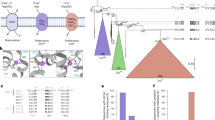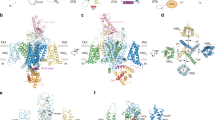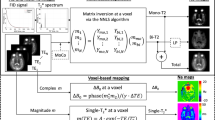Abstract
PROTEINS are often suggested to be the molecular components of excitable membranes which confer voltage-dependent permeability properties on nerve and muscle cells. Because of the relatively low concentration of the protein molecules directly responsible for ionic conductances compared with other membrane components, the isolation, characterisation, and reconstitution of these proteins is still at a rather early stage. Certain aspects of the molecular nature of the conductance mechanisms of excitable tissues, however, can be deduced using chemical reagents which specifically modify protein molecules. In particular, the sodium inactivation process can be eliminated by treatment with various proteolytic enzymes1–3,6. Of these, trypsin is probably the most selective, cleaving mainly at arginyl or lysyl residues4. Several investigators have suggested that just such an exposed positively charged residue might be responsible for blocking the sodium conductance pathway to produce inactivation5,6. Therefore, it should be possible to alter or remove inactivation by changing the configuration and/or charge of the blocking residue with a reagent specific for the residue involved. Glyoxal, phenylglyoxal and condensed 2,3-butanedione are three such reagents which are very reactive with the guanidino group of arginine7–9. This paper describes the effect on sodium inactivation of these agents when they are internally perfused in the squid axon.
This is a preview of subscription content, access via your institution
Access options
Subscribe to this journal
Receive 51 print issues and online access
$199.00 per year
only $3.90 per issue
Buy this article
- Purchase on SpringerLink
- Instant access to full article PDF
Prices may be subject to local taxes which are calculated during checkout
Similar content being viewed by others
References
Rojas, E. & Armstrong, C. M. Nature new Biol. 229, 177–178 (1971).
Armstrong, C. M., Bezanilla, F. & Roias, E. J. gen. Physiol. 62 (1973).
Rudy, B. Thesis, Cambridge Univ. (1976).
Keil, B. in The Enzymes (ed. Boyer, P. D.) (Academic, London, 1971).
Armstrong, C. M. & Bezanilla, F. J. gen. Physiol. (in the press).
Rojas, E. & Rudy, B. J. Physiol., Lond. 262, 501–531 (1976).
Nakaya, K., Horinishi, H. & Shibata, K. J. Biochem. 61, 345–351 (1976).
Takahashi, K. J. biol. Chem. 243, 6171–6179 (1968).
Yankeelov, Jr, J. A., Mitchell, C. D. & Crawford, T. H. J. Am. chem. Soc. 90, 1664–1666 (1968).
Baker, P. E., Hodgkin, A. L. & Shaw, T. I. Nature 190, 885 (1961).
Fishman, H. M. J. Biophys. 10, 799 (1970).
Wu, C. H. & Narahashi, T. J. Pharmac. exp. Ther. 184, 155 (1973).
Fishman, H. M. IEEE Trans. Biomed. Eng. 20, 380–382 (1973).
Grossberg, A. L. & Pressman, D. Biochemistry 7, 272–279 (1968).
Sheehan, C. J. & Hlavka, J. J. J. org. Chem. 21, 439–441 (1956).
Fraenkel-Conrat, H. & Mecham, D. K. J. biol. Chem. 177, 477–486 (1949).
Author information
Authors and Affiliations
Rights and permissions
About this article
Cite this article
EATON, D., BRODWICK, M., OXFORD, G. et al. Arginine-specific reagents remove sodium channel inactivation. Nature 271, 473–476 (1978). https://doi.org/10.1038/271473a0
Received:
Accepted:
Issue date:
DOI: https://doi.org/10.1038/271473a0
This article is cited by
-
Structure, function and expression of voltage-dependent sodium channels
Molecular Neurobiology (1993)
-
Modification of electrophysiological and pharmacological properties of K channels in neuroblastoma cells induced by the oxidant chloramine-T
Pfl�gers Archiv European Journal of Physiology (1990)
-
Modification of Na channel inactivation by ?-chymotrypsin in single cardiac myocytes
Pfl�gers Archiv European Journal of Physiology (1990)
-
The nonselective cation channel in the basolateral membrane of rat exocrine pancreas
Pflügers Archiv - European Journal of Physiology (1989)
-
Interaction between bradykinin and voltage-sensitive sodium channels in myelinated nerve fibers
Experientia (1989)



